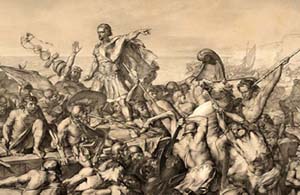Caesar's invasions of Britain
| Caesar's invasions of Britain | |||||||||
|---|---|---|---|---|---|---|---|---|---|
| Part of Caesar's Gallic Wars | |||||||||
 Edward Armitage's reconstruction of the first invasion |
|||||||||
|
|||||||||
| Belligerents | |||||||||
| Roman Republic and Trinovantes | Britons | ||||||||
| Commanders and leaders | |||||||||
| Julius Caesar, Commius, Trebonius, Mandubracius | Cassivellaunus, Cingetorix, Segovax, Carvilius, Taximagulus | ||||||||
| Strength | |||||||||
| 55 B.C – Around 10,000 legionary troops (Legio VII, Legio X), 80 infantry transport ships and an unknown number of cavalry forces. 54 B.C – Around 25,000 legionary troops (Legio VII and 4 other legions), unknown numbers of cavalry forces and transports. |
Unknown numbers of cavalry, infantry and chariots (4000 chariots attested in 55 BC) | ||||||||
In the course of his Gallic Wars, Julius Caesar invaded Britain twice: in 55 and 54 BC. The first invasion, in late summer, was unsuccessful: gaining the Romans little else besides a beachhead on the coast of Kent. The second invasion achieved more: the Romans installed a king, Mandubracius, who was friendly to Rome, and they forced the submission of Mandubracius's rival, Cassivellaunus. No territory was conquered and held for Rome; instead, all Roman-occupied territory was restored to the allied Trinovantes, along with the promised tribute of the other tribes in what is now eastern England.
Britain had long been known to the classical world as a source of tin. The coastline had been explored by the Greek geographer Pytheas in the 4th century BC, and may have been explored even earlier, in the 5th, by the Carthaginian sailor Himilco. But to many Romans, the island, lying as it did beyond the Ocean at what was to them the edge of the "known world," was a land of great mystery. Some Roman writers even insisted that it did not exist, and dismissed reports of Pytheas's voyage as a hoax.
Britain during the reign of Julius Caesar had an Iron Age culture, with an estimated population of between one and four million. Archaeological research shows that its economy was broadly divided into lowland and highland zones. In the lowland southeast, large areas of fertile soil made possible extensive arable farming, and communication developed along trackways, such as the Icknield Way, the Pilgrims' Way and the Jurassic Way, and navigable rivers such as the Thames. In the highlands, north of the line between Gloucester and Lincoln, arable land was available in only isolated pockets, so pastoralism, supported by garden cultivation, was more common than settled farming, and communication was more difficult. Settlements were generally built on high ground and fortified, but in the southeast, oppida had begun to be established on lower ground, often at river crossings, suggesting that trade was becoming more important. Commercial contact between Britain and the continent had increased since the Roman conquest of Transalpine Gaul in 124 BC, and Italian wine was being imported via the Armorican peninsula, much of it arriving at Hengistbury Head in Dorset.
...
Wikipedia
